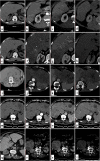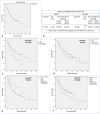The clinicopathological and prognostic factors of hepatocellular carcinoma: a 10-year tertiary center experience in Egypt
- PMID: 36117166
- PMCID: PMC9484175
- DOI: 10.1186/s12957-022-02764-2
The clinicopathological and prognostic factors of hepatocellular carcinoma: a 10-year tertiary center experience in Egypt
Abstract
Background: Hepatocellular carcinoma (HCC) remains a major health problem despite the emergence of several preventive and therapeutic modalities. HCC has heterogeneous and wide morpho-molecular patterns, resulting in unique clinical and prognostic criteria. Therefore, we aimed to study the clinical and pathological criteria of HCC to update the morpho-molecular classifications and provide a guide to the diagnosis of this disease.
Methods: Five hundred thirty pathologically analyzed HCC cases were included in this study. The clinical and survival data of these cases were collected.
Results: Hepatitis C virus is still the dominant cause of HCC in Egypt. Post-direct-acting antiviral agent HCC showed an aggressive course compared to interferon-related HCC. Old age, male gender, elevated alpha-fetoprotein level, tumor size, and background liver were important prognostic parameters. Special HCC variants have characteristic clinical, laboratory, radiological, prognostic, and survival data. Tumor-infiltrating lymphocytes rather than neutrophil-rich HCC have an excellent prognosis.
Conclusions: HCC is a heterogenous tumor with diverse clinical, pathological, and prognostic parameters. Incorporating the clinicopathological profile per specific subtype is essential in the treatment decision of patients with HCC.
Trial registration: This was a retrospective study that included 530 HCC cases eligible for analysis. The cases were obtained from the archives of the Pathology Department, during the period between January 2010 and December 2019. Clinical and survival data were collected from the patients' medical records after approval by the institutional review board (IRB No. 246/2021) of Liver National Institute, Menoufia University. The research followed the guidelines outlined in the Declaration of Helsinki and registered on ClinicalTrials.gov (NCT05047146).
Keywords: DAAs; Hepatitis C virus; Hepatocellular carcinoma; Pathological subtypes; prognosis.
© 2022. The Author(s).
Conflict of interest statement
The authors declare that they have no competing interests.
Figures







Similar articles
-
Post-treatment levels of α-fetoprotein predict incidence of hepatocellular carcinoma after interferon therapy.Clin Gastroenterol Hepatol. 2014 Jul;12(7):1186-95. doi: 10.1016/j.cgh.2013.11.033. Epub 2013 Dec 7. Clin Gastroenterol Hepatol. 2014. PMID: 24321207
-
Newly diagnosed hepatocellular carcinoma in patients with advanced hepatitis C treated with DAAs: A prospective population study.J Hepatol. 2018 Aug;69(2):345-352. doi: 10.1016/j.jhep.2018.03.009. Epub 2018 Mar 16. J Hepatol. 2018. PMID: 29551707
-
Serum α-fetoprotein level at treatment completion is a useful predictor of hepatocellular carcinoma occurrence more than one year after hepatitis C virus eradication by direct-acting antiviral treatment.J Viral Hepat. 2022 Jan;29(1):35-42. doi: 10.1111/jvh.13625. Epub 2021 Oct 27. J Viral Hepat. 2022. PMID: 34661320
-
AGA Clinical Practice Update on Interaction Between Oral Direct-Acting Antivirals for Chronic Hepatitis C Infection and Hepatocellular Carcinoma: Expert Review.Gastroenterology. 2019 Jun;156(8):2149-2157. doi: 10.1053/j.gastro.2019.02.046. Epub 2019 Mar 13. Gastroenterology. 2019. PMID: 30878469 Free PMC article. Review.
-
Prevention of hepatocellular carcinoma and its recurrence in chronic hepatitis C patients by interferon therapy.Clin Gastroenterol Hepatol. 2005 Oct;3(10 Suppl 2):S141-3. doi: 10.1016/s1542-3565(05)00713-5. Clin Gastroenterol Hepatol. 2005. PMID: 16234063 Review.
Cited by
-
Tumor organoid biobank-new platform for medical research.Sci Rep. 2023 Feb 1;13(1):1819. doi: 10.1038/s41598-023-29065-2. Sci Rep. 2023. PMID: 36725963 Free PMC article.
-
The impact of alpha-fetoprotein (AFP), child-turcotte-pugh (CTP) score and disease staging on the survival of hepatocellular carcinoma (HCC) patients: a retrospective cohort from single oncology center.Oncol Res. 2024 Dec 20;33(1):149-160. doi: 10.32604/or.2024.050903. eCollection 2025. Oncol Res. 2024. PMID: 39735678 Free PMC article.
-
Surgical Strategies for Recurrent Hepatocellular Carcinoma after Resection: A Review of Current Evidence.Cancers (Basel). 2023 Jan 13;15(2):508. doi: 10.3390/cancers15020508. Cancers (Basel). 2023. PMID: 36672457 Free PMC article. Review.
-
Peripheral immune signatures associated with the risk of hepatocarcinogenesis in cirrhotic Egyptian HCV patients before and after treatment with direct-acting antivirals.Virol J. 2024 Nov 15;21(1):293. doi: 10.1186/s12985-024-02551-3. Virol J. 2024. PMID: 39548562 Free PMC article.
-
Gd-EOB-DTPA enhanced MRI nomogram model to differentiate hepatocellular carcinoma and focal nodular hyperplasia both showing iso- or hyperintensity in the hepatobiliary phase.BMC Med Imaging. 2024 Aug 12;24(1):211. doi: 10.1186/s12880-024-01382-6. BMC Med Imaging. 2024. PMID: 39134943 Free PMC article.
References
-
- Holah N, El-Azab D, Aiad H, Sweed D. Hepatocellular carcinoma in Egypt: epidemiological and histopathological properties. Menoufia Med J. 2015;28(3):718–724.
-
- Rashed WM. Current HCC Clinical and Research in Egypt. In: Liver Cancer in the Middle East. Cham: Springer; 2021. p. 313–21.
MeSH terms
Substances
Associated data
LinkOut - more resources
Full Text Sources
Medical

